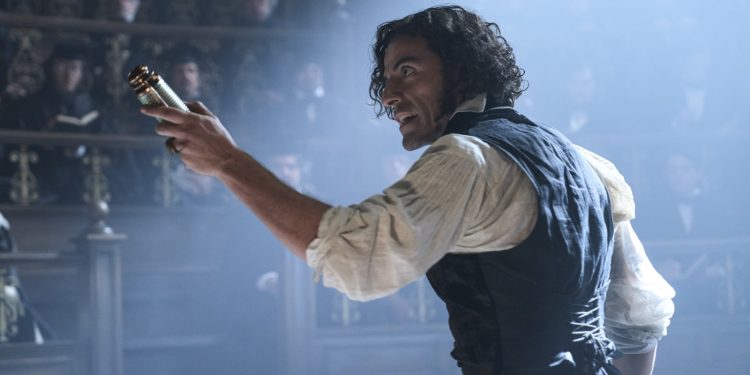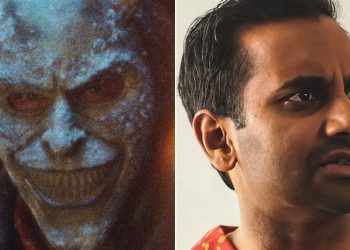Oscar Isaac as Victor Frankenstein in Frankenstein.
Ken Woroner/Netflix
hide caption
toggle caption
Ken Woroner/Netflix
Guillermo del Toro has made several monster films of a particular bent – moving, swooning, feverish films about grotesque-looking creatures that turn out to be more profoundly human than the humans who reject them. hell boy (2004) was a half-demon with a full heart. The amphibian man in The shape of water (2017) He was an emo f-boy with gill slits. Even the titular puppet in Pinocchio by Guillermo del Toro (2022) was such a mensch that he earned the right to exchange his knotty pine countenance for a sack of flesh.
Moving, swooning, feverish, with a narrative that stacks the emotional deck in favor of the hideous outcast – I mean, it’s about the dust jacket copy you’ll find on any volume of Mary Shelley’s 1818 novel. FrankensteinRIGHT?

That’s why it seems like the perfect combination of story and muse; Del Toro has certainly been talking about creating his own version of the tale for decades, calling it a “lifelong dream.”
That dream is now realized, and while the resulting film captures the tone and spirit of the original novel in all its jaw-dropping zeal and passed out-on-the-couch delirium, the many narrative tweaks del Toro makes—some of which work, some of which don’t—ensure that you’ll never be wrong about his Frankenstein for someone else.
A monster registers

Boris Karloff in his role as the monster Frankenstein.
AP/AP
hide caption
toggle caption
AP/AP
It’s light years away, for example, from James Whale’s iconic 1931 version, which surgically implanted Boris Karloff’s lumbering, flat-topped, bolt-necked monster into the culture. Because while Whale was true to the bones (heh) of the novel, Karloff’s creature never grew, intellectually or aesthetically. Perhaps Whale feared this would rob the monster of its primal power to force its way into its audience’s nightmares.
The Creature in the book, for its part, submits to a sort of hilarious autodidactic speed race, devouring The Lives of Plutarch And The sorrows of young Werther and, famously, Paradise lost. This is why you get the following disconnection:
Creature from the book: “I should be your Adam; but I am rather the fallen angel, whom you drive away from joy without any mischief. »
Karloff’s creature: “BAD FIRE”.
There are many more Creature books at del Toro Frankensteinwhich is good, because his monster inhabits the (literally, in this case) sculpted frame and Jacob Elordi’s brooding gaze. For about half his screen time, Elordi is more or less in “FIRE BAD” mode, tripping over yellowish strips of fabric that, intentionally or not (but let’s face it, probably intentionally) evoke the gold lamé speedo sported by his Rocky Horror Picture Show analog.

Jacob Elordi as the creature in Frankenstein.
Ken Woroner/Netflix
hide caption
toggle caption
Ken Woroner/Netflix
But soon after, the creature installs this very important upgrade: it secretly observes the daily life of a loving family, befriends their kindly blind patriarch (David Bradley), and enjoys their readings. Elordi makes its Creature 2.0 just as convincing as the launch version; now equipped with the full set of DLC on human emotions (rage, yes – but also gratitude, empathy, grief and regret), he sets out to confront Victor (Oscar Isaac), his arrogant, arrogant brat of a creator.
This all comes straight from Shelley’s novel, of course – it’s simply influenced by del Toro’s firmly-on-the-sleeve maximalist sensibility that extends to absolutely everything on screen. The production design is extremely difficult, with living rooms so immense that their walls disappear into shadow, landscapes so vast that they swallow up the characters – and the buildings they occupy.

Victor’s Solitary Tower – the creature’s birth site – is a gargoyle-adorned ruin atop a cliff so open to the elements that its rooms and staircases are filled with leaves and other bits of decaying organic matter. Its tiled floors feature gaping pits like frozen whirlpools, eerie but strangely beautiful.
Spare parts
But del Toro’s take on the material goes beyond just how it looks: he’s made several changes to the story that leave you wondering how much narrative work they’re actually doing, plus adding unnecessary complications to justify the film’s two and a half hours.
He devotes a lot of attention – much more than the book – to the life of young Frankenstein (heh), played by Christian Convery. Charles Dance adds yet another “stern father” performance to an IMDB page full of them, as Victor’s demanding father, and their icy, slightly sadistic relationship is clearly intended to foreshadow the one Victor will have with his creature. I couldn’t help but think of Tim Burton’s film Charlie and the Chocolate Factoryand his mysterious determination to explain to us that Wonka only became the candy maker he did because his father was… a dentist.

The film also features Christoph Waltz as Harlander, a mysterious character who acts as Victor’s financial patron. The character ostensibly exists to contrast Victor’s scientific zeal with the greedy drive of capitalism, but I can’t shake the belief that he could easily make it out of the film without leaving a hole.
A subplot involving Mia Goth’s Elizabeth represents another significant change that is confusing at first: why make Elizabeth the fiancée of Victor’s brother William (Felix Kammerer) instead of just making her Victor’s fiancée, as she is in the book?
The answer lies in the biggest and most essential change del Toro makes to the story here, which is turning Victor into an equal character. more of a fool – and, by extension, to make the creature even more sympathetic.
It’s there, in Victor’s bluff, cocky, arrogant version of Isaac, constantly declaring his genius to anyone within earshot. It’s there, in his snarling disgust at Elordi’s poor chained creature. And that’s where Victor tries to seduce his own brother’s fiancée.

Elizabeth, for her part, is totally on board with del Toro’s efforts to get us on the side of the Creature; Goth shows us a young woman smart and confident enough to recognize that beneath all the sutures and skin grafts, it’s still Jacob Freaking Elordi we’re talking about, people, here.
Del Toro doesn’t stop there – he also sidesteps the more unsavory aspects and actions of the book-Creature to highlight his version’s dewy-eyed soul and further cement its status as a blameless thing gravely wronged by the world in general, and by Victor in particular. It’s a marked adjustment from the novel, to be sure, but one that seems inevitable, given del Toro’s body of work and his single-minded need to portray the outsider as a hero.
He’s never been subtle about it, and he’s not here either: At one point, a character looks at Victor. “You He’s the monster,” they tell him.
I can’t hope to convey, reader, how wildly unnecessary this line is, given literally everything about the movie we’ve watched up to that point. It’s Del Toro gilding a lily that he’s already spent more than two hours painstakingly shaping from pure 24-karat gold.
And yet it works, for him, and for his film. Del Toro couldn’t do anything less and, given how perfectly suited he is to telling this story in this particular way, you wouldn’t want him to.
This piece also appeared on NPR’s Pop Culture Happy Hour newsletter. Subscribe to the newsletter so you don’t miss the next one and receive weekly recommendations on what makes us happy.
Listen to Pop Culture Happy Hour on Apple Podcasts And Spotify.









